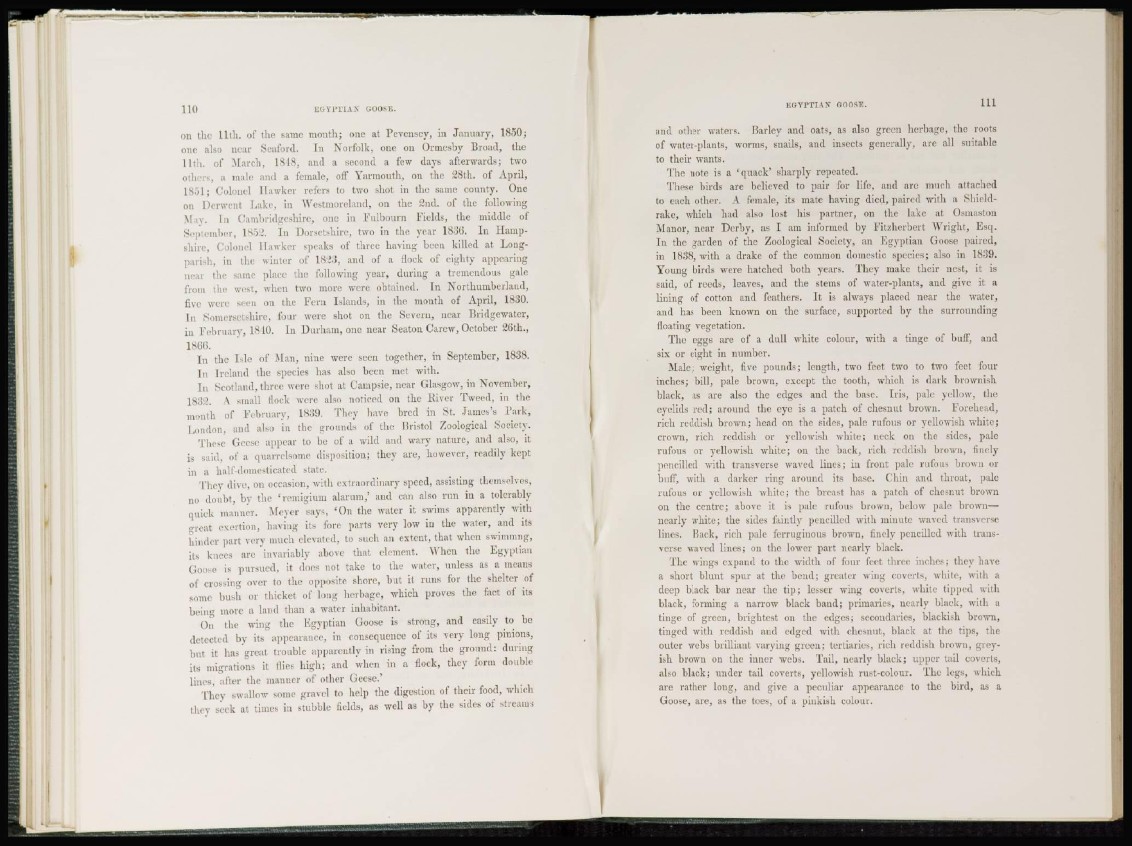
on the 11th. of the same month; one at Pevcnsey, in January, 1850;
one also near Seaford. In Norfolk, one on Ormesby Broad, the
11th. of March, 1848, and a second a few days afterwards; two
others, a male and a female, off Yarmouth, on the 28th. of April,
1851; Colonel Hawker refers to two shot in the same county. One
on Derwent Lake, in Westmoreland, on the 2nd. of the following
May. In Cambridgeshire, one in Fulbourn Fields, the middle of
September, 1852. In Dorsetshire, two in the year 1836. In Hampshire,
Colonel Hawker speaks of three having been killed at Lougpaii
h, in the winter of 1823, and of a flock of eighty appearing
near the same place the following year, during a tremendous gale
from the west, when two more were obtained. In Northumberland,
five were seen on the Fern Islands, in the month of April, 1830.
I n Somersetshire, four were shot on the Severn, near Bridge water,
in February, 1810. In Durham, one near Seaton Carew, October 26th.,
18G6.
I n the Isle of .Man, nine were seen together, in September, 1838.
In Ireland the species has also been met with.
I n Scotland, three were shot at Campsie, near Glasgow, in November,
1832. A small flock were also noticed on the River Tweed, in the
month of February, 1839. They have bred in St. James's Park,
London, and also in the grounds of the Bristol Zoological Society.
These Geese appear to be of a wild and wary nature, and also, it
is said, of a quarrelsome disposition; they are, however, readily kept
in a half-domesticated state.
They dive, on occasion, with extraordinary speed, assisting themselves,
no doubt, by the 'remigium alarum,' and can also run in a tolerably
quick manner. Meyer says, 'On the water it swims apparently with
great exertion, having its fore parts very low in the water, and its
hinder pari very much elevated, to such an extent, that when swimmng,
its knees are invariably above that element. When the Egyptian
Goose is pursued, it does not take to the water, unless as a means
of crossing over to the opposite shore, but it runs for the shelter of
some bush or thicket of long herbage, which proves the fact of its
being more a land than a water inhabitant.
On the wing the Egyptian Goose is strong, and easily to be
detected by its appearance, in consequence of its very long pinions,
but it has great trouble apparently in rising from the ground: during
its migrations it Hies high; and when in a flock, they form double
lines, after the manner of other Geese.'
They swallow some gravel to help the digestion of their food, -which
they seek at times in stubble fields, as well as by the sides of streams
E G Y P T I A N GOOSE. I l l
and other waters. Barley and oats, as also green herbage, the roots
of water-plants, worms, snails, and insects generally, are all suitable
to their wants.
The note is a 'quack* sharply repeated.
These birds are believed to pair for life, and are much attached
to each other. A female, its mate having died, paired with a Shieldrake,
which had also lost his partner, on the lake at Osmaston
Manor, near Derby, as I am informed by Fitzherbcrt Wright, Esq.
I n the garden of the Zoological Society, an Egyptian Goose paired,
in 1838, with a drake of the common domestic species; also in 1839.
Young birds were hatched both years. They make their nest, it is
said, of reeds, leaves, and the stems of water-plants, and give it a
lining of cotton and feathers. It is always placed near the water,
and has been known on the surface, supported by the surrounding
floating vegetation.
The eggs are of a dull white colour, with a tinge of buff, and
six or eight in number.
Male; weight, five pounds; length, two feet two to two feet four
inches; bill, pale brown, except the tooth, which is dark brownish
black, as are also the edges and the base. Iris, pale yellow, the
eyelids red; around the eye is a patch of chesnut brown. Forehead,
rich reddish brown; head on the sides, pale rufous or yellowish white;
crown, rich reddish or yellowish white; neck on the sides, pale
rufous or yellowish white; on the back, rich reddish brown, finely
pencilled with transverse waved lines; in front pale rufous brown or
buff, with a darker ring around its base. Chin and throat, pale
rufous or yellowish white; the breast has a patch of chesnut brown
on the centre; above it is pale rufous brown, below pale brown—
nearly white; the sides faintly pencilled with minute waved transverse
lines. Back, rich pale ferruginous brown, finely pencilled with transverse
waved lines; on the lower part nearly black.
The wings expand to the width of four feet three inches; they have
a short blunt spur at the bend; greater wing coverts, wdrite, with a
deep black bar near the t i p ; lesser wing coverts, while tipped with
black, forming a narrow black band; primaries, nearly black, with a
tinge of green, brightest on the edges; secondaries, blackish brown,
tinged with reddish and edged with chesnut, black at the tips, the
outer webs brilliant varying green; tertiaries, rich reddish brown, greyish
brown on the inner webs. Tail, nearly black; upper tail coverts,
also black; under tail coverts, yellowish rust-colour. The legs, which
are rather long, and give a peculiar appearance to the bird, as a
Goose, are, as the toes, of a pinkish colour.